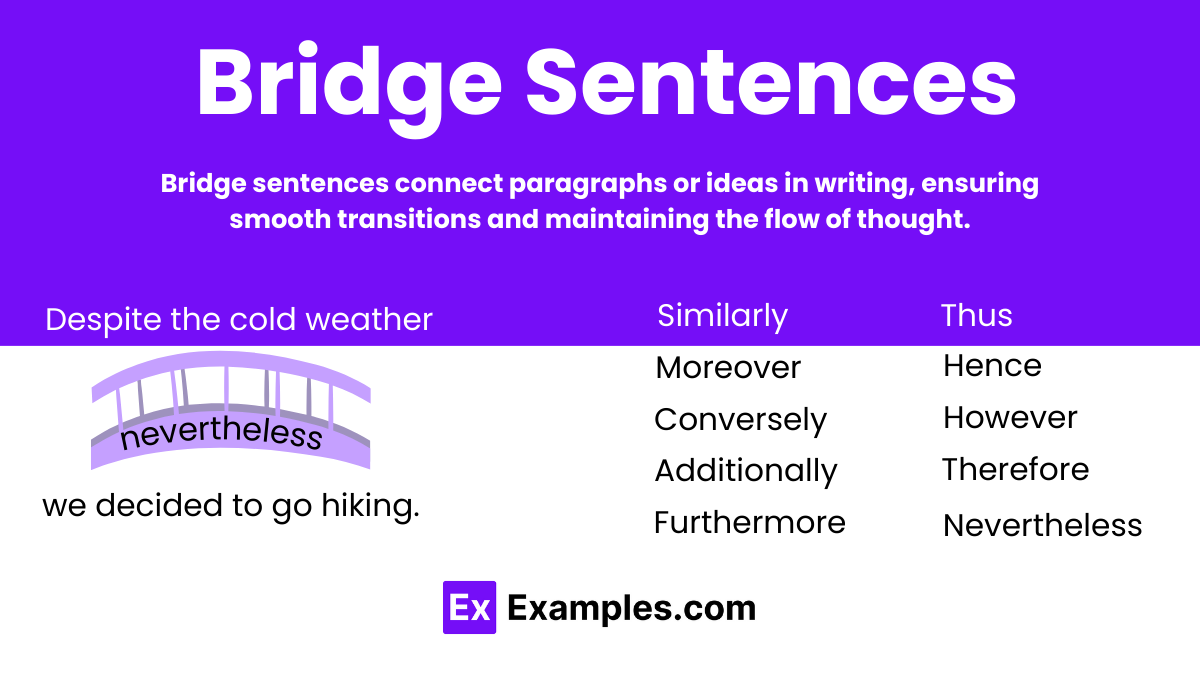Bridge Sentences

Imagine a world without bridges, and we mean the bridges that connect pieces of land together for us to travel from one place to another. The bridge could be as short as those build over rivers or as long as the Golden Gate Bridge along the Pacific, yet their purpose remains the same. In a similar sense, bridge sentences in writing and speech serve as transitions to connect two similar or opposing ideas together. In this article, we will discuss the basic function of bridge sentences in communication.
What are Bridge Sentences – Defining
A bridge sentence, also known as a paragraph bridge, is a type of topic sentence that helps connect an old paragraph or idea to a new one. It conveys what the new paragraph is about and how it relates to the one introduced prior to it. The trick to doing so is to create a smooth shift of thoughts by bringing these ideas closer together. If the bridge isn’t constructed properly, then it will fail to convey the right message to its readers. These transitions can sometimes be found in the first line of the paragraph, but you can also find them at the end of a paragraph in some cases.
Short Bridge Sentences
- Moving from historical context to current applications, it’s clear that this technology has evolved significantly.
- On a related note, this brings us to another significant aspect.
- However, this perspective changes when we look at the situation from a different angle.
- Furthermore, this development has implications for both our short-term strategies and long-term goals.
- Conversely, critics argue that this approach may overlook some fundamental concerns.
- Building upon this point, we can see how it directly influences other trends in the field.
- Despite these advancements, several challenges remain unresolved.
- Next, let’s turn our attention to the effects of these changes.
- To better understand this phenomenon, a closer examination of the data is necessary.
Simple Bridge Sentences
- Let’s now consider another aspect of the same issue.
- This leads us to the next point.
- Similarly, we see a related pattern emerging in other areas.
- Contrasting with this idea, another perspective highlights a different issue.
- With this in mind, we can further explore the implications.
- This sets the stage for understanding the broader impact.
- Moreover, this connection is crucial for our discussion.
- This example clearly illustrates the main point.
- Turning to a different example, we can see how this applies in other contexts.
- To delve deeper, let’s examine a specific case.
Words to Start Bridge Sentences
| Additionally | Furthermore | Moreover | Conversely | Similarly |
| As a result | Subsequently | Therefore | Thus | Hence |
| On the other hand | Consequently | Nevertheless | However | Next |
| Following this | Meanwhile | Then | Accordingly | To illustrate |
| In contrast | On a similar note | Leading on from | In addition to | Before moving on |
| Finally | Initially | In conclusion | As previously stated | Moreover |
What is the Purpose of Bridging Paragraphs?
While writing an essay or any academic or business paper, using transitional devices such as bridge sentences is essential in connecting similar thoughts together. This serves as an escort from a previous topic being discussed to a new one.

For example, the bridge sentence of an introductory paragraph is typically found between the ‘hook’ and the thesis statement. The hook is crafted to draw attention, while the bridge sentence is used to slowly introduce the thesis statement to readers. They serve as a clue for readers to understand what was being mentioned in a given article or study, what will be discussed next, and how the two topics relate to one another.
The function of a bridge sentence within multiple paragraphs of an essay writing is also similar to the one previously stated. But, instead of starting each paragraph with a topic sentence, the bridge is used to create a smooth transition of thoughts. Here, the speaker briefly discusses the previous point given in order to tie it to a new point.
Types of Transitions
When it comes to writing a paper, bridge sentences are generally referred to as transitional statements. These statements may consist of a few words or they can make up a whole sentence outline or paragraph. But, keep in mind that these transitions would depend on the relationship being conveyed in the write-up. To understand the proper use of these transitions, you can study the following types:
- Sequential Transitions – Bridge sentences with sequential transitions that demonstrate a logical flow of ideas in a write-up. For example, words such as ‘thus’, ‘therefore’, and ‘then’ show a relationship between the past and the current point being discussed.
- Comparative Transitions – This type of transitional words and phrases can come in handy, especially when the relationship between two ideas isn’t so obvious. These words serve as an effective instrument in drawing analogies that are difficult to comprehend at first. Examples of such include words and phrases like ‘also’, ‘just as’, ‘like’, and ‘similarly’.
- Contrastive Transitions – For instances when you’re neither looking at similarities nor describing relationships but instead focusing on contrasting qualities, these transitions can be extremely useful. Not only can these transitions help emphasize central ideas in a compare-and-contrast essay, but they can also help debunk a claim or point out the opposite side of an issue. Examples that fall under this category include ‘though’, ‘but’, ‘however’, ‘nevertheless’, ‘nonetheless’, ‘then again’, ‘on the other hand’, and ‘at the same time’. You may also see Short Sentence Example.
- Summing Up Transitions – After proving your point, you’d want to throw in that one last thought, to sum up, every important detail provided. To ensure that readers don’t miss the main idea of your paragraph or article, these transitional sentences can help in introducing your final thought in a quick yet appropriate manner. Transitional words in this category include ‘essentially’, ‘basically’, ‘ultimately’, ‘in short’, and ‘in other words’.
Examples of Bridge Sentences
Listed below are brief samples of paragraphs consisting of bridge sentences. The bridge sentence in these examples have been italicized for your reference: You may also see Cumulative Sentence Example.
Example #1
Sandra and her father played out in the rain despite the strong protest coming from her mother. They danced to the tune of the rain and watched as each droplet fell from the dark skies. She smiled, thinking of the days when she and her father listened helplessly to the endless rants of her mother as their soaking bodies form small puddles of water inside the house. You may also see Balanced Sentence Examples.
Now, thirty years later, Sandra looks back to these memories with tears filling her baby blues.
Example #2
The documentary concluded its feature with North Korean soldiers dumping corpses onto a military truck.
Why would any news program carry such gruesome footage? Surely they knew what the consequences were for doing so…Instead, representatives from the news network considered it newsworthy because the clips featured exclusive content and startling visual images that viewers were interested in. You may also see Complex Sentence Example.
Example #3
The World Health Organization began forming a highly-classified group of scientists to study the outpouring origins and effects of disease X. Though the disease remains unknown to society, it is likely to be a hybrid of past diseases that have been carried by animals. The team of scientists was tasked to discover the possible symptoms of the disease, along with the regions it is likely to spread in first. You may also see Compound Sentence Examples.
In other words, disease X is an existing, scientifically-generated epidemic that is yet to sweep a mass number of the earth’s population in the near future.

Ultimately, the main objective of a bridge sentence is to help promote clear communication. By defining the relationship between two separate ideas, readers are able to grasp the connection that exists between them. This creates a smooth flow of thoughts to provide an exceptional reading experience for individuals. You may also see Parallel Sentence Example.
Bridge Sentences for Class 1
- Now, let’s talk about something else.
- Next, we are going to learn about…
- Let’s move on to our next fun fact.
- After that, we did… Now, we will do…
- First we learned about A, now let’s look at B.
- Do you remember what we did yesterday? Today, we’re going to learn more about it.
- We finished our story, now let’s draw a picture of our favorite part.
- We counted apples before. Now, let’s count oranges.
- Let’s put away our books and get out our art supplies.
- We sang a song about the weather, now let’s look outside to see what the weather is doing today.
Bridge Sentences for Class 2
- We just read about animals. Now, let’s write our own story about a lion.
- We finished our math worksheet. Next, we’ll use blocks to show what we learned.
- We learned how plants grow. Let’s draw pictures of a plant’s life cycle.
- After playing our counting game, now we will count all the chairs in our classroom.
- We talked about the weather yesterday. Today, we’ll make a weather chart.
- First, we learned about addition. Now, let’s try some subtraction problems.
- Now that we’ve cleaned up our area, let’s gather around for story time.
- We’ve just finished learning our new words. Let’s use them in sentences now.
- We colored pictures in the morning; now, let’s write about the pictures after lunch.
- We talked about healthy foods; next, we will cut out pictures of foods to make our own healthy meal.
Bridge Sentences for Class 3
- Now that we’ve read about dinosaurs, let’s compare them to animals living today.
- We just learned about multiplication. Let’s apply it by calculating how many apples are in these baskets.
- After discussing the water cycle, let’s create a mini water cycle model in class.
- We’ve written our own fairy tales. Now, let’s read them aloud to the class.
- We’ve explored maps of our country. Next, let’s look at maps of other countries and find the differences.
- Now that we know how to measure length, let’s find objects around the classroom to practice measuring.
- We learned about ancient Egypt; now let’s write a day in the life of an Egyptian child.
- After our lesson on planets, let’s use balls of different sizes to create a model of the solar system.
- We discussed the importance of recycling; now, let’s sort these materials into recyclables and non-recyclables.
- We’ve practiced fractions with pizza slices; next, let’s use the same idea with a chocolate bar.
1. Continuation Bridges
- These sentences extend the thought from the previous paragraph or introduce additional information that complements the preceding ideas.
- Example: “Furthermore, continuing this program will not only benefit current participants but also future generations.”
2. Contrast Bridges
- Used to introduce a contrasting or opposing viewpoint to the one just discussed, helping to highlight differences.
- Example: “However, despite the previous success of the initiative, recent reports suggest a decline in its effectiveness.”
3. Cause and Effect Bridges
- These bridge sentences explain the cause and effect relationships between ideas, showing how one event leads to another.
- Example: “Consequently, the sudden drop in temperature last winter caused significant damage to the crop yields.”
4. Similarity Bridges
- They draw parallels between two ideas, emphasizing similarities and connections.
- Example: “Similarly, the economic policies of Country X have mirrored the early stages of economic development seen in Country Y.”
5. Clarification Bridges
- These are used to clarify or further explain a point or idea that might not have been fully understood.
- Example: “To clarify, the new policy does not replace the old one but rather expands upon the existing regulations.”
6. Emphasis Bridges
- Emphasis bridges are employed to stress the importance or critical nature of a point just discussed.
- Example: “Indeed, this evidence highlights the urgent need for reform within the sector.”
7. Conclusion Bridges
- Used to signal that a conclusion or summary is forthcoming, wrapping up the discussion.
- Example: “In conclusion, the multiple benefits of this approach clearly outweigh its drawbacks.”
8. Time Sequence Bridges
- These help organize narratives or processes by marking the progression of time or steps.
- Example: “Subsequently, after the initial trials were successful, the next phase of the project commenced.”
How to Write Bridge Sentences
1. Understand the Purpose of Bridge Sentences
- Transition: Bridge sentences help readers move from one paragraph or section to another seamlessly.
- Prediction: They can set the stage for what is coming next, preparing the reader for a shift in tone, argument, or topic.
- Reflection: Bridge sentences can also reflect on the content just covered, making a connection between the previous information and new ideas.
2. Identify the Connection
- Start by clearly understanding the content of both the preceding and following paragraphs.
- Identify the key elements that connect these two paragraphs. This could be a shared theme, a contrasting point, or a cause-and-effect relationship.
- Continuation transitions (furthermore, moreover, additionally) are used when adding similar information or expanding on a point.
- Contrast transitions (however, on the other hand, conversely) introduce an opposing viewpoint or a shift in direction.
- Cause and effect transitions (therefore, as a result, thus) demonstrate the relationship between actions and outcomes.
- Chronological transitions (next, then, after) are useful in narrative or process writing to show the progression of time or steps.
4. Craft the Sentence
- Keep the bridge sentence concise and to the point.
- Use it to gently guide the reader from one idea to the next, ensuring the sentence fits the tone and style of your writing.
- Make sure it incorporates key terms or concepts that are central to both paragraphs, enhancing the thematic continuity of your text.
5. Evaluate its Effectiveness
- After writing your bridge sentence, read the transition aloud to see if it naturally guides you from one idea to the next.
- Check if the bridge sentence helps clarify the relationship between paragraphs. If the connection still feels jarring or abrupt, consider revising the sentence.
Why are bridge sentences used?
Bridge sentences connect paragraphs or sections, ensuring a smooth transition in writing, aiding coherence, and guiding readers from one idea to another seamlessly.
What is a bridge sentence in analogies?
In analogies, a bridge sentence explains the relationship between two seemingly unrelated topics, clarifying how one idea or example parallels or contrasts with another.
How to use the verb bridge in a sentence?
The verb “bridge” denotes the act of making connections or overcoming gaps; e.g., “This meeting aims to bridge the communication gap between departments.”
What are good bridge sentences?
Good bridge sentences effectively link ideas, clarify transitions, and maintain the flow of text, often incorporating transitional phrases like ‘furthermore’, ‘however’, or ‘consequently’.




